REVIEW: Sly Cooper and the Thievius Raccoonus
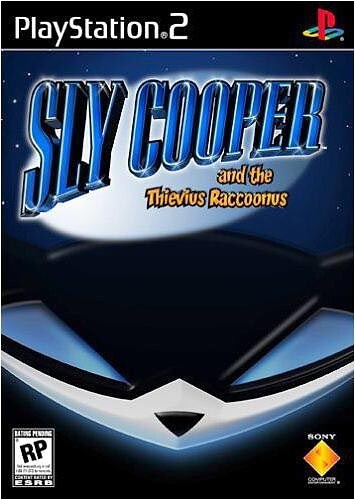 Like Robin Hood in Sherwood Forest, Sly Cooper, along with his band of merry thieving orphans, is a beloved figure in these parts.
Like Robin Hood in Sherwood Forest, Sly Cooper, along with his band of merry thieving orphans, is a beloved figure in these parts.Sly 2: Band of Thieves, which I reviewed last year, is one of my kids' all-time favorite video games.
Sly 3: Honor Among Thieves, which I'll get around to reviewing one of these days, is a terrific game as well. We had a great time playing it a few months ago.
Although Sly Cooper and the Thievius Raccoonus is the first game in the series, we didn't get around to playing it until now. But the fact that we went out of order didn't affect our enjoyment of this game, which was considerable.
Since I already discussed the series' visual style and backstory, and addressed possible concerns about endorsing thievery in my Sly 2 review, I won't rehash them here. But like the 2nd and 3rd games in the series, playing Sly Cooper and the Thievius Raccoonus is like exploring inside a great comic book.
As with many of the games we play together, we first played the demo of this game on a PlayStation Jampack disc. And based on that demo, I have to admit that I didn't think we'd like the first Sly game as much as we enjoyed the later versions, but as it turned out, I shouldn't have worried. Sly Cooper and the Thievius Raccoonus is an out-freakin'-standing game. The tight controls and sense of humor are present and accounted for, and the characters are terrific.
That said, there were a few issues, especially when comparing this game to its successors.
Clue Bottles: In Sly 2, smashing the bottles holding various clues wasn't an essential part of the game, but in this game, if you don't find the requisite amount of clues, you'll miss out on some valuable new skills and abilities. This is most unfortunate, because it's a pain in the ass to get them all, which means that backtracking (including dying on purpose so you could start from the top to take another (literal) whack at the clue bottles) is the order of the day. This gets easier when you earn a tool that reveals where all the clues are, but of course, you have to find all the clues on a previous level to get it.
Voice-overs: Most of the voicework is very solid, and I particularly appreciate that the same three actors (Kevin Miller as Sly, the underappreciated Matt Olsen as Bentley, and Chris Murphy as Murray) voice the three main characters throughout the series. The same can't be said of every character, and in fact, Inspector Carmelita Fox is voiced by a different actor every time, with this one being the worst of the three (beating out the Sly 3 version in a squeaker). Ironically, the best one is Alesia Glidewell - the very same Alesia Glidewell I criticized for her horrible job voicing the conniving Constable Neyla in Sly 2.
Controls: Muscle memory-related control confusion was another issue for me. If you want to run fast, you press the R1 button in Sly 2, but in the first Sly game, you have to press the triangle button. As a result, instead of running away from the rabid guard dogs, I paused for a leisurely look-see with my binoculars, resulting on a nice bump on the coconut.
Additionally, there is less free exploration than in Sly 2 and Sly 3, and Sly Cooper is the only playable character, as opposed to Sly 2 (Sly, Murray, and Bentley) and Sly 3 (Sly, Murray, Bentley, Carmelita, Dmitri, The Guru, Penelope, and Sly 1 villain the Panda King). Of course, this simply means that the series just keeps getting better.
Speaking of better things, Sly Cooper and the Thievius Raccoonus has the best rhythm mini-game we've ever played (feel free to quote me on that one).
A few months back, I wrote one of my pituitary "mega-reviews" about the rhythm game genre. While the games I highlighted are full-fledged rhythm games, many many other video games incorporate at least one rhythm based mini-game into the gameplay. Some do it well. Some do it exceedingly poorly. But more often than not, it's an unwelcome intrusion - an annoying, unnecessary, discordant hurdle that interrupts the flow of the game; detracting from, rather than enhancing the gameplay.
That's not the case here. This game gets right what so many other games get wrong. The mini-game makes sense in the context of the level, and it excels both rhythmically and visually. The X, square, circle and triangle buttons don't simply move lifelessly across the screen on a conveyor belt. Oh, no. Voodoo mystic Mz. Ruby flings them at you like lethal rhythmic projectiles. Additionally, the platforming that leads into the mini-game is rhythm-based as well. As you make your way to battle Mz. Ruby, you have to avoid stalactites that rhythmically slam down like gator jaws, as you spire jump from peak to peak. My kids absolutely love this level, and although we've only been playing the game for a couple weeks, we've replayed it many many times already.
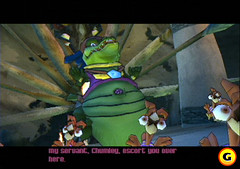
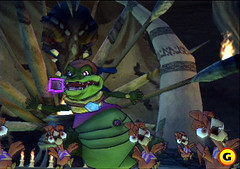
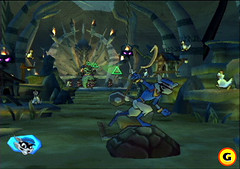
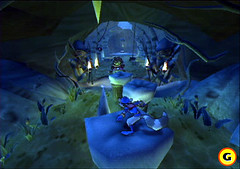
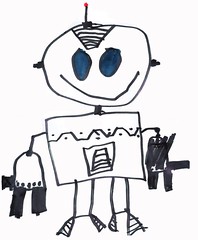



0 Comments:
Post a Comment
<< Home